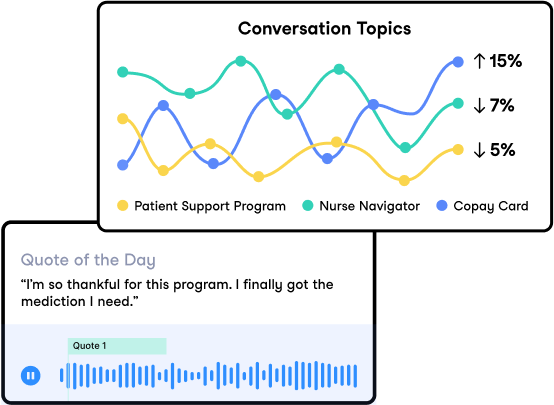
Your patients are talking. Are you listening?
Healthcare is complex (and confusing to your patients). Conversational analytics listens to patient interactions already happening and offers actionable insights.
Start ListeningAuthenticx analyzes customer conversations to surface recurring trends.
Healthcare is changing.
Are you adapting your strategy? You wouldn’t go to a doctor that couldn’t offer a diagnosis. The same rule applies to the data tools being leveraged to monitor customer experience.
Read the Case Study
Over 50,000 customer interactions demonstrate how pervasive disruptions in the healthcare customer journey continue to be.
Patient Engagement In Healthcare
The healthcare industry in the United States is one of the most complex industries in the world – not just for patients but for healthcare providers as well. Laws vary from state to state, and there are also federal laws and regulations which must be observed and adhered to. And the complexity of the system only increases when you add in insurance providers, pharmaceutical companies, and other healthcare specialists. One of the ways to make sense of all the cacophony is for organizations or providers to invest in substantive strategies for patient engagement in healthcare. Because sometimes healthcare is a life or death industry, it’s vitally important that patients and healthcare providers have access to the best tools and methodologies that provide the best possible healthcare outcomes.
While ‘patient engagement’ is a broad term that can encompass many things, it most commonly refers to the inclusion of the patient and their knowledge and skills to help supplement the care provided to them by a healthcare provider or facility. Patient engagement can refer to efforts to encourage patients to take preventative care measures, exercise regularly, or limit the consumption of harmful substances like tobacco and alcohol products. Some studies have shown that healthcare organizations with better patient engagement strategies can sometimes result in better healthcare outcomes for the patient.
Even relatively healthy individuals who may not need to rely on the healthcare system that much should still regularly visit their primary care physician to receive their regular check-ups and any necessary health screenings based on factors like age, family history, and other contributing factors. And very few patients have an expansive knowledge of healthcare procedures or “health literacy,” so it can be difficult for care providers and patients alike to know if they are receiving the proper care. Continuity of care means that healthcare is patient-centered, and a dedicated team of medical professionals may cooperate in providing ongoing healthcare services or treatment.
While the precise meaning of patient engagement may vary depending on who you talk to, patient engagement in healthcare can supplement healthcare providers’ knowledge of a patient’s medical history, provide patients with a better understanding of their diagnosis, treatment regimen, or anything else related to the process or quality of their care. Patient engagement can also be as simple as following up with an email or text message after visiting a healthcare facility to ask patients to fill out a survey or questionnaire. Whether direct or indirect, patient engagement is slowly changing the landscape of the healthcare industry.
Patient Engagement Strategies
When healthcare providers or organizations seek to augment better patient engagement strategies or develop a more robust framework for patient engagement, patients can oftentimes experience greater health outcomes. Even though a doctor or nurse practitioner – or any medical professional for that matter – has ample experience, training, and education, numerous treatments rely heavily on the ability and/or willingness on the part of the patient in order for the treatment to be effective. The more communication between healthcare providers and patients, the more likely patients are to follow instructions with regard to their healthcare.
By utilizing evidence-based patient engagement strategies, hospitals, healthcare facilities, and healthcare providers can develop a more substantive patient engagement plan. On an individual level, a patient engagement plan would likely involve a communicative collaboration between the patient and their healthcare provider(s) to devise a treatment regimen that is as simple and effective as possible. While not every patient may experience a positive health outcome, enhancing patient engagement strategies and techniques can have a positive impact on patient health outcomes overall, while simultaneously improving the patient experience. And when patients have better experiences at healthcare facilities, they are generally more likely to recommend that healthcare provider, facility, etc. to a friend or loved one which can be especially advantageous to private practices and less well-known healthcare providers.
Patient involvement in healthcare decision-making can be an empowering experience for the patient, and in some cases, it can provide medical professionals with the necessary information to be able to provide the best possible care. While doctors, nurses, and other medical professionals may have all of the expertise and training to provide excellent care, patients know their bodies better than anyone else and can help provide additional information to healthcare providers that may be crucial in developing an effective treatment plan.
Patient Engagement Tools
By leveraging patient engagement tools or utilizing patient engagement activities, healthcare providers or organizations can help ensure that patients receive the best possible care. Patient engagement tools can be diverse and multifaceted, but they all generally strive to increase communication and transparency between the patient and health care provider. Better communication and transparency can lead to fewer medical errors, misdiagnoses, and misunderstandings between patients and their healthcare providers.
Another effective engagement strategy for interacting with patients is digital patient engagement. For example, when a healthcare company has an online portal that patients can access online 24/7, patients have much greater access to schedule appointments, follow-up exams, payments, and much more. Additionally, patients can access any necessary documents shared by their doctor or healthcare provider that are relevant to their treatment. The patient can do these things on their own time with little or no assistance and can subsequently save healthcare providers valuable time and resources that they can then reinvest into other patients.
Digital patient engagement can also help healthcare facilities streamline their operations as using better technology platforms can be quicker and easier to navigate. By relying on a patient engagement solution, things like patient satisfaction surveys, upcoming appointment reminders, registration forms, health advertising campaigns, and much more can all be handled automatically which frees staff up to handle more pressing concerns related to the healthcare facility’s daily operations.
Patient engagement statistics can then provide healthcare organizations with valuable insights into what matters most to patients. Too frequently, healthcare can devolve into a numbers game, but the people involved are living, breathing, sentient beings with complex internal lives, hopes, and desires. With better patient engagement strategies, patients can feel more heard and empowered by their ability to contribute to the success of their desired health outcome.
Related Resources
- Pharma Patient Engagement
- Patient Experience Feedback
- Patient Experience Platform
- Patient Feedback Surveys
- Hospital Patient Satisfaction Survey
- Qualitative Feedback
- Telehealth Patient Satisfaction Survey
- Customer Experience Management
- Primary Care Patient Experience Survey
- Patient Satisfaction Surveys In Healthcare
How It Works
Gain a deeper level understanding of contact center conversations with AI solutions.
See a PreviewAggregate
Pull customer interaction data across vendors, products, and services into a single source of truth.
Analyze
Collect quantitative and qualitative information to understand patterns and uncover opportunities.

Activate
Confidently take action with insights that close the gap between your organization and your customers.
Patient Engagement Examples
In the broadest terms, an example of patient engagement would be any time the patient communicates directly with the healthcare provider, staff, or personnel within a healthcare facility or any time a healthcare provider reaches out to communicate directly with the patient. Patient engagement in healthcare examples can come in a variety of different forms. Common examples may include an engagement strategy that seeks to inform a patient with a chronic illness about the ways in which the patient can manage their daily symptoms, what types of medication they should be taking, and how often.
Other patient engagement examples may include outreach initiatives. Sometimes healthcare facilities will send out information about seasonal allergies, flu vaccines, and other important healthcare information. Sometimes healthcare organizations engage in marketing strategies to bring in new patients or remind current patients to schedule an appointment. These patient engagement strategies are also necessary for the survival and successful operation of many healthcare businesses.
Sometimes patient engagement can be as simple as a healthcare professional monitoring the self-administration of medication. Regardless of the specifics, patient engagement can be an invaluable tool for patients and medical professionals alike. When a patient is more engaged with the process, it can help improve outcomes for everyone involved. Like kids in the classroom – learning can be more fun, and students can retain more information when actively engaged with the work. Teachers can expect to see better grades and test scores; the school can see better averages on exam scores, and patient engagement works very similarly and can provide similar positive outcomes.
Benefits Of Patient Engagement
When it comes to patient engagement and health outcomes, there are obviously a number of benefits involved, especially when patients have an overall positive experience. When healthcare providers or professionals utilize unhelpful patient engagement strategies or no strategies at all, patients may not feel as invested in their care or they may not feel comfortable speaking up to express their concerns. But within the healthcare industry, a patient that feels comfortable speaking up when they have a concern can be the difference between life and death, so it’s vitally important for healthcare organizations to invest in effective patient engagement methodologies.
Many of the benefits of involving patients in decision-making in healthcare speak for themselves; indeed, it would be difficult to overstate the importance of patient engagement in healthcare. When patients feel more involved in their own healthcare, they are generally more likely to remember important information and take the management of their treatment more seriously.
The benefits of patient engagement can extend well beyond the patient’s treatment or stay within a healthcare facility. Ultimately, the benefits of better patient engagement strategies are numerous – they can improve the quality of care, increase employee satisfaction, reduce employee turnover, and potentially improve patient outcomes and financial performance. More satisfied employees are more likely to provide better quality care just like more satisfied patients are more likely to adequately follow up with appointments and keep track of other necessary aspects of their treatment.